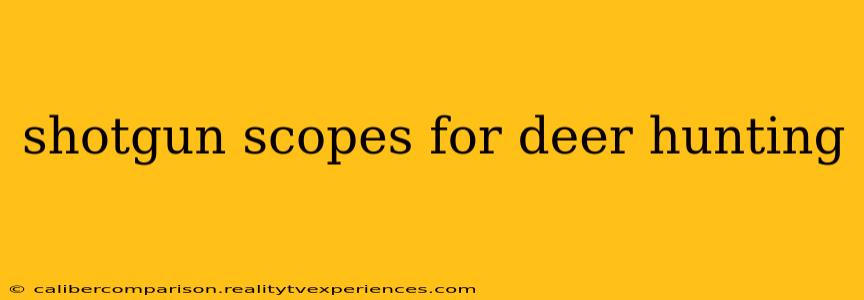Deer hunting with a shotgun presents unique challenges and opportunities. While traditional iron sights are perfectly adequate for close-range shots, the addition of a shotgun scope significantly extends your effective range and accuracy, particularly in low-light conditions or when hunting in thicker cover. Choosing the right scope, however, requires careful consideration of several factors. This guide will walk you through everything you need to know to select the best shotgun scope for your deer hunting needs.
Understanding the Unique Needs of Shotgun Scopes for Deer Hunting
Shotgun scopes differ from rifle scopes in several crucial ways. Shotguns typically have a larger bore and generate more recoil than rifles. This means your scope needs to be robust enough to withstand the punishment and maintain zero. Additionally, shotgun slugs—unlike rifle bullets—have a wider dispersion pattern, meaning precise aiming is still critical even with a scope.
Key Features to Consider When Choosing a Shotgun Scope
Several key features will significantly influence your hunting success and the longevity of your scope. Let's break down the essential aspects:
1. Magnification: Finding the Right Balance
Magnification is crucial for longer shots. For deer hunting, a variable magnification scope (e.g., 1-4x, 2-7x, or 3-9x) offers versatility. A lower magnification setting provides a wider field of view, ideal for quick target acquisition in close-quarters situations. Higher magnification allows for more precise shots at longer ranges. Consider the typical distances you'll be shooting at when making your decision. A 3-9x scope is a popular and versatile choice for many deer hunters.
2. Reticle: Choosing the Right Aiming Point
The reticle is the crosshair pattern inside your scope. Different reticles cater to various hunting styles and shooting distances. Simple duplex reticles are excellent for quick target acquisition, while more complex reticles, like ballistic reticles, aid in compensating for bullet drop at longer ranges. Consider a reticle that is easy to see in various light conditions and doesn't obscure your view of the target.
3. Tube Diameter: Strength and Light Transmission
Shotgun scopes typically come in 1-inch or 30mm tube diameters. 30mm tubes generally offer better light transmission, which is crucial in low-light hunting situations. They also tend to be more robust and capable of handling the higher recoil of a shotgun. However, 1-inch tubes are lighter and more compact.
4. Objective Lens Diameter: Maximizing Light Gathering
The objective lens is the front lens of the scope. A larger objective lens gathers more light, improving low-light performance. A larger objective lens also typically increases the scope's weight and size.
5. Eye Relief: Avoiding Damage and Ensuring Comfort
Eye relief refers to the distance between your eye and the eyepiece. Adequate eye relief is essential to avoid getting your eye bruised by recoil. Look for a scope with ample eye relief, especially when using a powerful shotgun.
6. Durability and Construction: Withstanding the Recoil
A shotgun scope needs to be built tough. Look for scopes constructed from durable materials like aircraft-grade aluminum and sealed to withstand harsh weather conditions and recoil. Nitrogen-filled scopes are less susceptible to fogging in changing weather.
Top Considerations for Mounting Your Shotgun Scope
Proper mounting is crucial for accuracy and safety. Ensure you use high-quality scope rings and bases designed specifically for your shotgun model. Properly torquing the scope rings and bases is essential to prevent movement and damage to the scope.
Conclusion: Finding the Perfect Shotgun Scope for Your Deer Hunting Needs
Selecting the right shotgun scope significantly enhances your deer hunting success. By considering the key factors outlined above—magnification, reticle, tube diameter, objective lens, eye relief, and durability—you can make an informed decision that matches your specific hunting style and preferences. Remember to prioritize safety and practice shooting with your chosen scope before heading into the field. Happy hunting!

